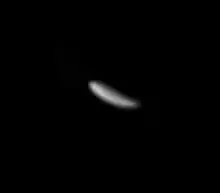Aegaeon (moon)
Aegaeon /iːˈdʒiːɒn/, or Saturn LIII (provisional designation S/2008 S 1), is a natural satellite of Saturn. It is thought to be similarly smooth as Methone.[6] It orbits between Janus and Mimas within Saturn's G Ring.
 Aegaeon imaged by the Cassini spacecraft from a distance of 15238.2 km in 2010 | |
| Discovery | |
|---|---|
| Discovered by | Carolyn Porco |
| Discovery date | March 3, 2009 |
| Cassini Imaging Science Team | |
| Designations | |
Designation | Saturn LIII |
| Pronunciation | /iːˈdʒiːɒn/[1] |
Named after | Αιγαίων Aigaiōn |
| Adjectives | Aegaeonian /iːdʒiːˈoʊniən/[2] |
| Orbital characteristics | |
| Epoch JD 2454467.00075444 TDB | |
| 167493.665±0.004 km [3] | |
| Eccentricity | 0.00042277±0.00000004 [3] |
| 0.80812 d [4] | |
| Inclination | 0.0007°±0.6° [3] |
| Satellite of | Saturn |
| Group | a source of the G Ring |
| Physical characteristics | |
| Dimensions | 1.4 km × 0.5 km × 0.4 km ± 0.1 km × 0.12 km × 0.16 km[5] |
Mean radius | 0.33±0.06 km[5] |
Mean density | 0.54+0.16 −0.13 g/cm3[5] |
| Albedo | < 0.15 |
Discovery and naming
Images of Aegaeon were taken by Cassini on 15 August 2008, and its discovery was announced on 3 March 2009 by Carolyn Porco of the Cassini Imaging Science Team using the provisional designation S/2008 S 1.[4]
Aegaeon was named after one of the hekatonkheires on 5 May 2009.[7]
Orbit
.jpg.webp)
.jpg.webp)
Aegaeon orbits within the bright segment of Saturn's G Ring, and is probably a major source of the ring.[8] Debris knocked off Aegaeon forms a bright arc near the inner edge, which in turn spreads to form the rest of the ring. Aegaeon orbits in a 7:6 corotation eccentricity resonance with Mimas,[3] which causes an approximately 4-year oscillation of about 4 km in its semi-major axis, and a corresponding oscillation of a few degrees in its mean longitude. It orbits Saturn at an average distance of 167,500 km in 0.80812 days, at an inclination of 0.001° to Saturn's equator, with an eccentricity of 0.0002.[4]
Physical characteristics
Aegaeon is the smallest known moon of Saturn and has a highly elongated shape, measuring 1.4 km × 0.5 km × 0.4 km (0.87 mi × 0.31 mi × 0.25 mi) in size.[9] Measurements of its mass, based on its interaction with the dust particles that make up the G ring arc the moon is embedded in, suggest a density similar to that of water ice.[10] Aegaeon has the lowest albedo, below 0.15, of any Saturnian moon inward of Titan.[10] This might be due to either darker meteoric material making up the dust in the G ring or due to Aegaeon having been disrupted, stripping away its ice-rich surface and leaving the rocky inner core behind.[10]
Exploration
The Cassini spacecraft has performed four flybys of Aegaeon closer than 20,000 km, though only one has occurred since it was discovered in 2008. The closest of these pre-discovery encounters took place on 5 September 2005 at a distance of 8,517 km.[11] An encounter on 27 January 2010 at a distance 13,306 km allowed Cassini to acquire its highest resolution images of Aegaeon to-date.[10] On 19 December 2015, Cassini was unable to acquire any images from a planned close flyby.
References
- Noah Webster (1884) A Practical Dictionary of the English Language
- Maravilla & Leal-Herrera (2014) 'The Saturnian G-Ring: A Short Note about its Formation', Revista Mexicana de Astronomía y Astrofísica, p. 342, 346, 347
- Hedman, M.M.; Cooper, N.J.; Murray, C.D.; Beurle, K.; Evans, M.W.; Tiscareno, M.S.; Burns, J.A. (May 2010). "Aegaeon (Saturn LIII), a G-ring object". Icarus. 207 (1): 433–447. arXiv:0911.0171. Bibcode:2010Icar..207..433H. doi:10.1016/j.icarus.2009.10.024.
- IAU Circular No. 9023
- Thomas, P. C.; Burns, J. A.; Tiscareno, M. S.; Hedman, M. M.; et al. (2013). "Saturn's Mysterious Arc-Embedded Moons: Recycled Fluff?" (PDF). 44th Lunar and Planetary Science Conference. p. 1598. Retrieved 2013-05-21.
- Battersby, S. (2013-05-17). "Saturn's egg moon Methone is made of fluff". www.newscientist.com. New Scientist. Retrieved 2013-05-21.
- Jennifer Blue, Saturnian Satellite Named Aegaeon, USGS Astrogeology Hot Topics, 5 May 2009
- Petite Moon, CICLOPS, 29 May 2009
- Thomas, P.C.; Burns, J.A.; Hedman, M.; Helfenstein, P.; Morrison, S.; Tiscareno, M.S.; Veverka, J. (2013). "The inner small satellites of Saturn: A variety of worlds" (PDF). Icarus. 226 (1): 999–1019. Bibcode:2013Icar..226..999T. doi:10.1016/j.icarus.2013.07.022. Retrieved 2 December 2015.
- Hedman, M.M.; Burns, J.A.; Thomas, P.C.; Tiscareno, M.S.; Evans, M.W. (2011). Physical Properties of the small moon Aegaeon (Saturn LIII) (PDF). European Planetary Space Conference. Icarus. 6. Archived from the original (PDF) on 4 March 2016. Retrieved 2 December 2015.
- Planetary Society Cassini Timeline
.jpg.webp)